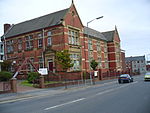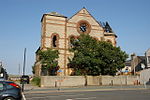St George's Church, Barrow-in-Furness
1861 establishments in England19th-century Church of England church buildingsChurch buildings by E. G. PaleyChurch of England church buildings in CumbriaChurches completed in 1861 ... and 8 more
Churches completed in 1883Churches in Barrow-in-FurnessDiocese of CarlisleEngvarB from September 2013Gothic Revival architecture in CumbriaGothic Revival church buildings in EnglandGrade II listed churches in CumbriaPaley and Austin buildings

St. George's Church is in St George's Square, Barrow-in-Furness, Cumbria, England. It is the oldest active Anglican parish church in the town. The church is in the deanery of Barrow, the archdeaconry of Westmorland and Furness, and the diocese of Carlisle. Its benefice is united with those of St Aidan, Newbarns, St Luke, Risedale, and St Perran, Roose, to form the South Barrow Team Ministry. The church is recorded in the National Heritage List for England as a designated Grade II listed building. It stands at the southeast extremity of the town.
Excerpt from the Wikipedia article St George's Church, Barrow-in-Furness (License: CC BY-SA 3.0, Authors, Images).St George's Church, Barrow-in-Furness
Lonsdale Street,
Geographical coordinates (GPS) Address External links Nearby Places Show on map
Geographical coordinates (GPS)
| Latitude | Longitude |
|---|---|
| N 54.1084 ° | E -3.2209 ° |
Address
St George
Lonsdale Street
LA14 2JJ , Barrow Island
England, United Kingdom
Open on Google Maps







